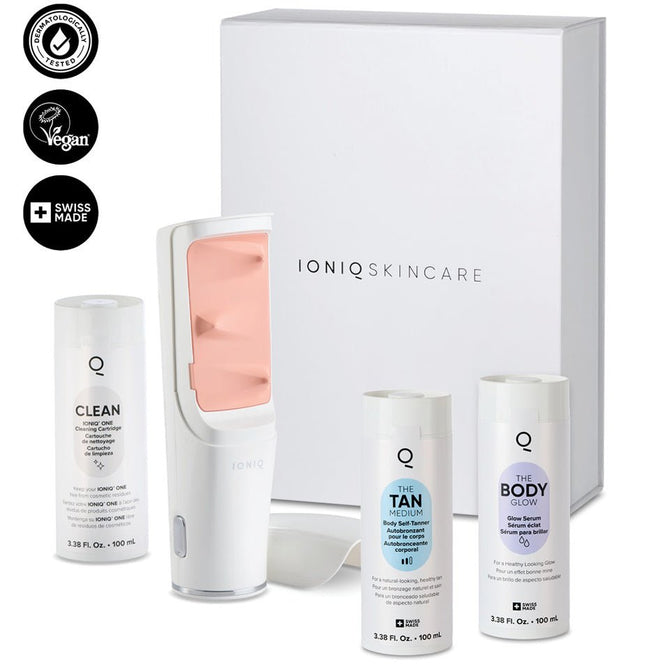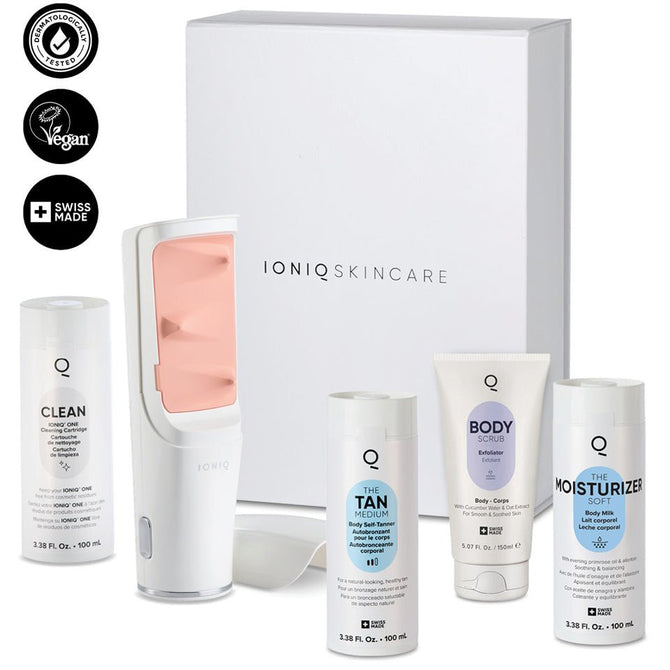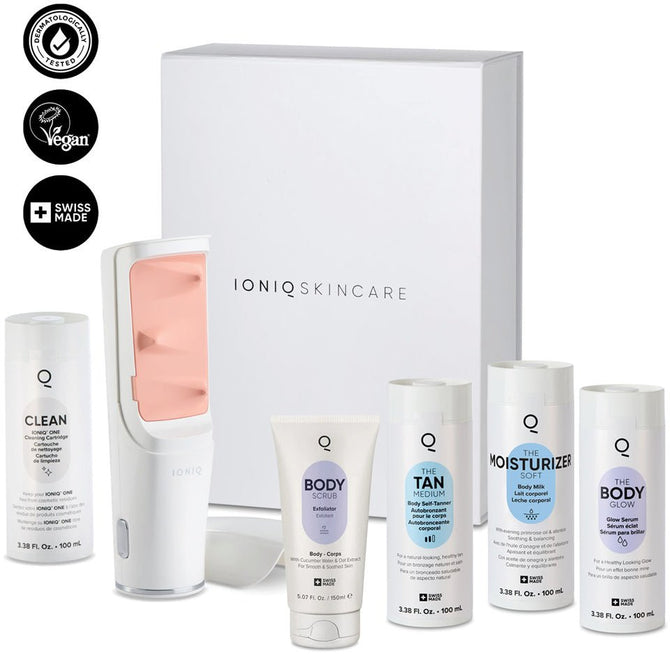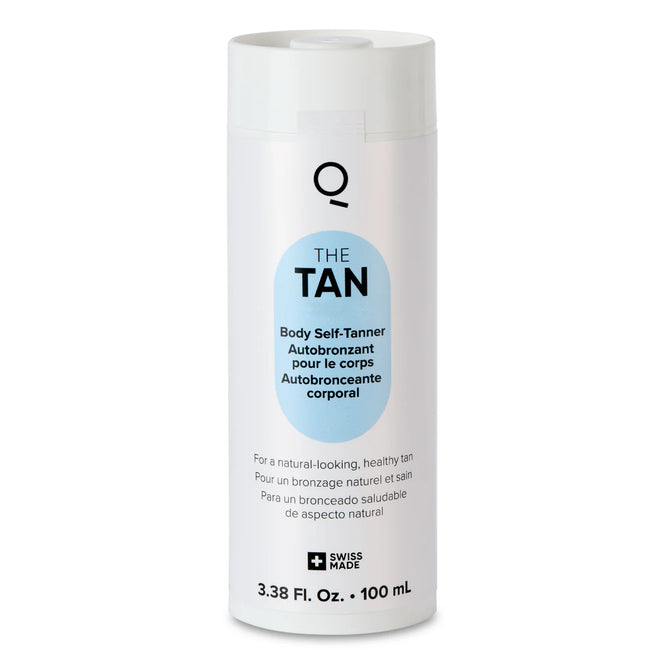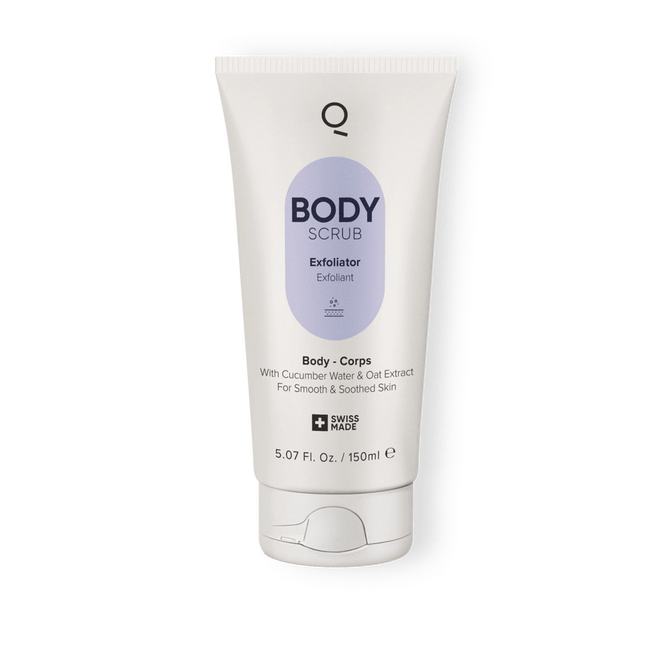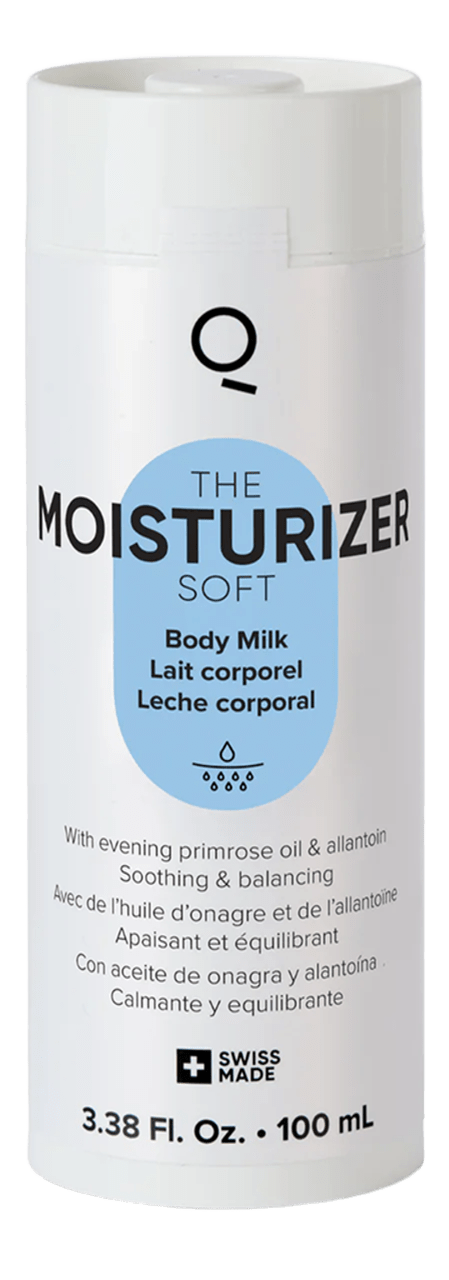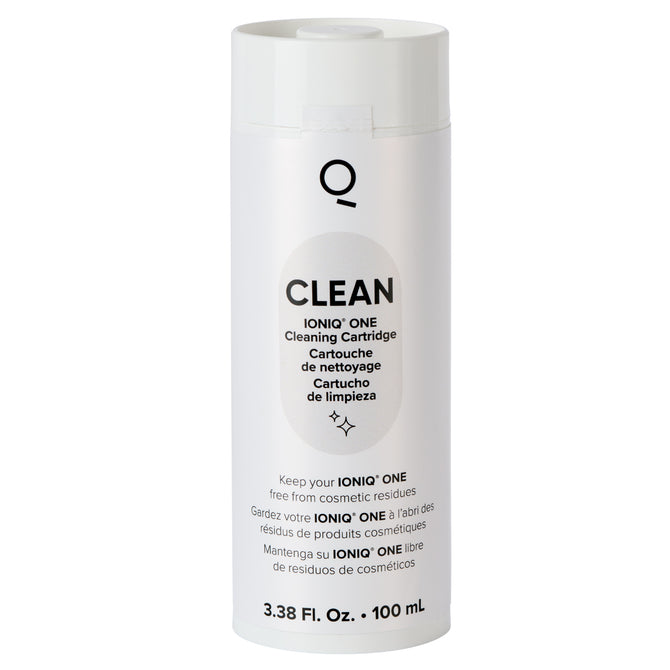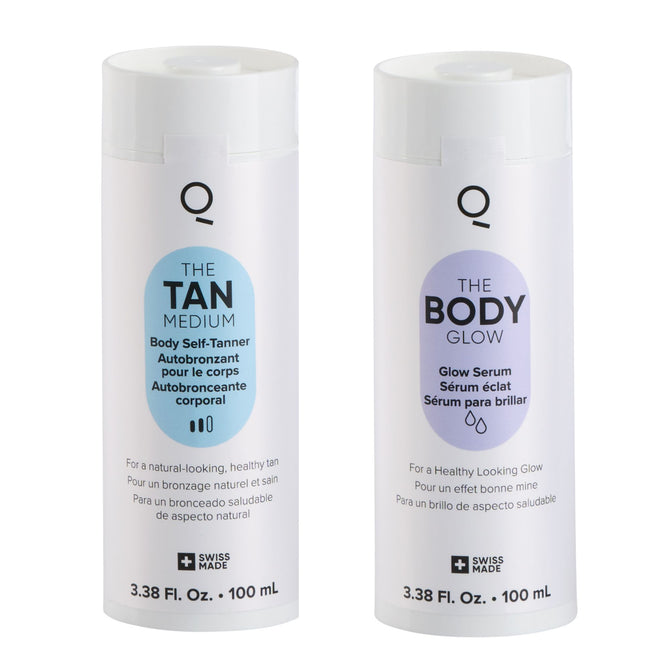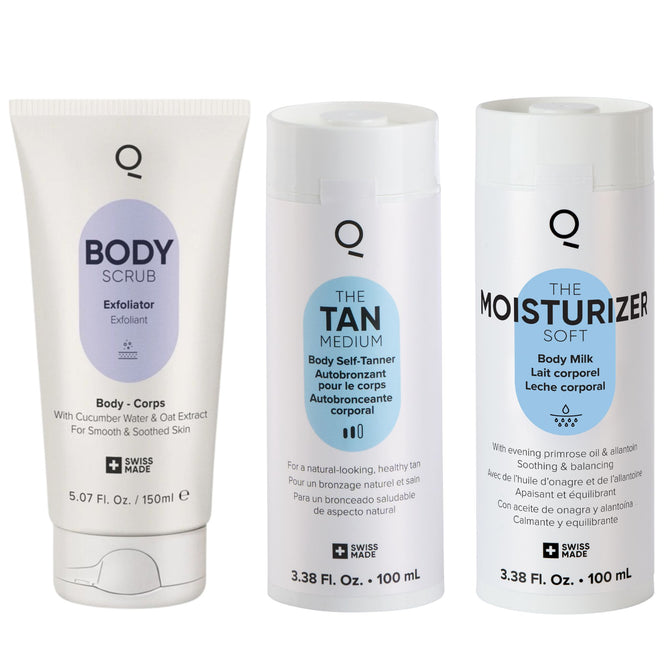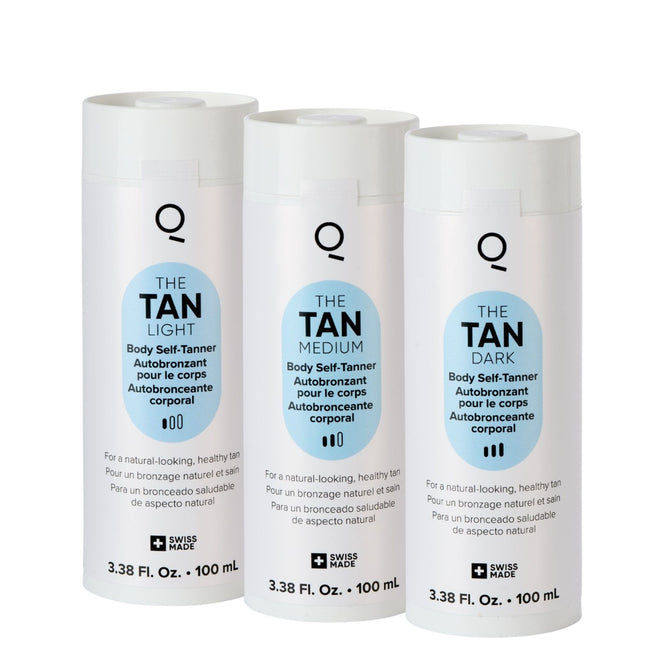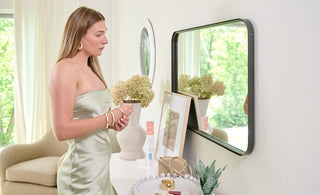
At IONIQ, we hear from so many people frustrated with how to self tan successfully. They try new products hoping for a smooth glow, only to end up disappointed. Maybe it’s an awkward orange tint, maybe it’s dark patches on knees or elbows, or maybe it’s streaks that didn’t show up until hours later.
No one wants to spend time and money learning how to self tan only to feel embarrassed by the results. And you’re far from alone - patchy, fake-looking tans happen to countless people who set out with the best intentions, thinking it would be a simple process.
If you’ve been let down by promises on the bottle before, we understand exactly why. Getting a flawless, natural tan from a bottle is harder than most admit, and for reasons that often have nothing to do with how carefully you applied it.
Why so many self-tanners end up with fake-looking results
A lot of people think the biggest issue is poor technique. They blame themselves, their mitt, or the way they stood in the bathroom. But while method matters, the real reasons most people struggle with how to self tan well have more to do with how self-tanners work - and how they react with your unique skin.
Uneven skin isn’t the only problem
It also comes down to the formula itself. Lower-quality DHA, combined with extra warm dyes or unstable colorants, makes it easy for your tan to slip from sun-kissed to orange. Some brands still use outdated stabilizers that clash with skin undertones, giving you an oddly brassy look.
On top of that, many standard tanning products count on you to manually spread everything perfectly. A mousse or lotion needs thorough blending to look seamless. If you overlap strokes too much or apply uneven pressure with your mitt, you might not notice anything wrong right away - but the flaws appear by morning.
Color guides can give a false sense of security
A lot of self-tanners use a cosmetic “guide color,” meaning a brown tint that shows instantly so you can see where you’ve applied. It sounds helpful, and sometimes it is. But these tints wash off in the shower, and often have little to do with the DHA reaction happening underneath.
So even if the guide layer looked flawless, your real tan could still show up streaky or patchy later.
The biggest myths about getting a natural tan from a bottle
Because so many people struggle to figure out how to self tan well, myths pop up everywhere. They promise shortcuts or rules that often don’t hold up.
Myth 1: The more product you use, the darker and longer your tan
People sometimes think piling on extra mousse or lotion will give them a deeper, longer-lasting result. But DHA can only react with the top layers of your skin. Once those layers are saturated, more product just sits on the surface, leading to sticky residue, uneven absorption, or product rubbing off on clothes and sheets.
In reality, a light, even application is key. If you want deeper color, it’s better to repeat the process the next day, building in controlled layers.
Myth 2: Exfoliating right before guarantees perfect results
Yes, exfoliation is important. It removes old, flaky cells that could turn your tan patchy. But overdoing it can strip or irritate your skin, raising its pH (we’ll talk about that later) and setting you up for color that develops poorly.
The best approach? Exfoliate lightly 24 hours before. Then moisturize dry spots like ankles, knees, and elbows the day you tan so they don’t over-absorb product.
Why Many People Still Get Orange: Understanding pH and Product Quality
The overlooked role of pH in tanning
Skin isn’t perfectly neutral on the pH scale. It usually sits around 4.5 to 5.5, which is slightly acidic. This helps protect your barrier and keeps the ecosystem of your skin healthy. But if your pH drifts too high - meaning it’s more alkaline - it can affect how DHA develops.
In a healthy acidic state, DHA tends to react into brownish pigments that look like a natural tan. But on alkaline skin, the reaction can skew, creating yellowish or orange tones.
Everyday habits that raise your pH
You might be changing your pH without realizing it. Things like:
-
Washing with harsh bar soaps
-
Taking long hot showers
-
Overusing exfoliating scrubs or peels
-
Applying heavy alkaline creams.
All of these disrupt your skin’s natural balance. That’s why two people can follow the same directions on how to self tan and end up with completely different color results.
Why product quality matters as much as your prep
Not all DHA is equal. Lower grades can include impurities that shift color payoff. Cheap tanners may rely on outdated stabilization methods, or add warm bronzers to cover uneven development, which ironically makes orange more likely.
Better solutions - like the TAN formula we use at IONIQ - pair pure DHA with carefully chosen boosters to control the reaction on your skin. Ours is also infused with aloe, which helps keep the skin hydrated and calm so the tan sets evenly.
The Secret Weapon: Using a Spray Tan Machine at Home
Why machines give better, more even coverage
Most people who first learn how to self tan start with lotions or mousses, paired with a mitt. It seems simple enough: blend in circles, watch where you’ve applied, hope you didn’t overlap. But technique matters hugely, and small mistakes add up to big problems by morning.
Spray systems change that by misting the solution onto your skin. Fine droplets settle more naturally, wrapping around curves without you needing to press or smear them. This lowers your risk of:
-
Streaks from uneven pressure
-
Overloaded dark spots where product pooled
-
Lines from overlapping mitt strokes.
However, many classic at-home spray machines rely on blowing the product out like paint. That can waste solution, make a mess of your bathroom, and still isn’t foolproof for even application.
How the IONIQ ONE Sprayer + TAN solves the streak and orange problem
At IONIQ, we wanted to completely rethink how to self tan - especially for people who’d tried everything and still wound up with frustrating results.
IONIQ ONE Sprayer, an at-home spray tan uses Magnetic Skin Technology. This means it actually charges the mist so it’s pulled toward your skin, wrapping around every inch evenly. Instead of hoping droplets land the right way, they’re gently drawn to your body, covering all angles with the same amount of product.
-
No rubbing in after.
-
No guessing where you missed.
-
No weird lines or patches the next day.
Because the coverage is so precise, our balanced DHA formula develops evenly and is less influenced by small pH swings on different parts of your skin. The result? A natural tan that fades just like a real sun tan would, without surprise orange splotches or rings.
How your skin’s pH can still impact your color - and how we help minimize it
We build our formulas with carefully adjusted pH to match your skin’s natural range, plus soothing ingredients that keep your barrier happy. This means less disruption, fewer surprises, and a color that stays truer to a sun-kissed glow.
Why Many People Still Get Orange: Understanding pH and Product Quality
At IONIQ, we’ve seen countless people eager to figure out how to self tan, only to end up with an oddly warm or outright orange color. It’s one of the biggest reasons people swear off self-tanners - not because they’re against at-home tanning, but because their results simply didn’t look believable.
The truth? It’s rarely just about your mitt technique. In fact, most of the time, that orange cast or splotchy look comes down to subtle details in how your skin interacts with the formula - day after day, layer after layer - and how stable that formula really is once you’ve cracked the bottle.
Your skin’s pH isn’t static - and that matters more than you’d think
Most guides on how to self tan talk about exfoliating or moisturizing. But very few explain how pH keeps changing. Your skin is naturally slightly acidic, which is great for helping DHA develop into those sun-kissed brown tones.
But your skin’s acidity shifts constantly based on tiny things:
-
The water you rinse with (hard water tends to raise pH).
-
Any leftover cleansers or face masks that linger.
-
Even environmental stressors like cold air or heat.
So while you might prep perfectly before tanning, your skin could be more alkaline the next day - especially after hot showers or sweat. That means if you reapply self-tanner to maintain color, the same product could develop differently, leaning orange in spots it looked fine on before.
This is why many people get frustrated trying to figure out how to self tan in a way that stays consistent. It’s not just about your first application; it’s how your skin’s microclimate changes over time.
Not all self-tanners handle these shifts well
Older formulations, or ones that rely on a heavy DHA load to promise ultra-dark color, tend to be more sensitive to pH changes. Their reactions on skin can easily tip from golden brown to brassy if your acid balance is slightly off.
At IONIQ, we’ve balanced our TAN solution to stay stable across a broader pH range. That means even if your skin is slightly more alkaline after a workout, you’re less likely to see harsh shifts toward orange. Our formula also skips the heavy added dyes some brands use to try to “cover up” this problem, which often makes it worse as the tan fades unevenly.
Why your bottle’s age changes everything
There’s another factor that surprises people learning how to self tan: self-tanner starts aging the moment you open it. DHA is naturally unstable. Exposure to air, light, and even just sitting on your bathroom shelf can start breaking it down.
What happens then?
-
The active DHA degrades into byproducts that don’t react with your skin the same way.
-
This changes the final shade, often pushing it toward unnatural yellow or orange hues.
-
Even if your technique is flawless, old solution develops poorly.
This is why we designed our IONIQ TAN cartridges to be sealed and pre-measured, so they stay fresh and stable until the last drop, without repeated air exposure. It keeps the chemistry clean, which keeps your results natural.
The unexpected truth about fading and patchiness
Lots of people are mainly worried about how to self tan without streaks right after application. But one of the biggest giveaways of a fake tan is how it fades.
Normal self-tanners simply coat the top layer of skin. As those cells start shedding, the tan breaks down at different rates on different areas of your body:
-
Places with more friction (like under waistbands or on thighs) lose color fast.
-
Drier or rougher zones hold on longer.
-
This creates visible rings or patchy areas - which stand out even more if the color leans orange.
Because our IONIQ approach uses wrap-around, ultra-even micro-droplets paired with a pH-balanced formula, it doesn’t overload certain patches. That means as your skin naturally renews, the fade looks more like a subtle sun tan disappearing evenly, not a spotty dye job peeling away.
How most people blame themselves - when it’s really a formula issue
It’s common to see people online asking for help with how to self tan better, thinking they didn’t exfoliate enough, didn’t wait long enough to shower, or didn’t blend well. While technique matters, it only goes so far.
If your self-tanner isn’t built to adapt to the tiny day-to-day pH swings your skin goes through, or if it’s starting to oxidize in the bottle after a few uses, even perfect prep can’t save your results.
Why your application method still makes or breaks the end look
We’ve found that many people learning how to self tan will carefully exfoliate, buy a high-end lotion, and still end up uneven simply because of how they apply it. Even with a good formula, using a mitt means you’re relying on your own pressure and blending. This leads to:
-
Thicker deposits where you paused or overlapped.
-
Lighter sections if you accidentally stretched skin differently (like bending an arm).
-
Subtle lines that only show up hours later.
Your skin’s daily shifts demand more than an ordinary product
When people first explore how to self tan, they mostly focus on immediate prep steps. But the reality is your skin’s ecosystem changes all the time. Tiny differences in pH from a sweaty day or a new cleanser can transform the same tanner’s payoff from golden brown to a weird rusty orange.
A truly modern tanning system needs to adapt to those shifts, minimizing the risk they show up on your skin. That’s why we developed our technology to pair a stable, pH-friendly formula with application that’s consistent down to the micro-level. The result is a tan that looks more like the sun did it, not a bottle.
Final thoughts on why orange still happens - and how to outsmart it
The reason so many people still struggle to figure out how to self tan without orange disasters isn’t because they’re doing anything wrong. It’s because most self-tanners, even expensive ones, still rely on old assumptions:
-
That your skin pH never changes.
-
That DHA always reacts the same way.
-
That your hands can blend with the precision of a machine.
At IONIQ, we see things differently. We understand your skin is dynamic. That’s why we engineered a solution that stays consistent even with small changes in your skin’s environment, and why we built a sprayer that ensures every part of you gets the same fine coating.
This isn’t just about avoiding orange. It’s about creating a look so natural that no one guesses you learned how to self tan - they just assume you spent a little extra time in the sun.
The Secret Weapon: Using a Spray Tan Machine at Home
At IONIQ, we know there are countless people trying to figure out how to self tan who still end up frustrated. They prep carefully, apply cautiously, then wait to see the final color - only to spot streaks, darker knees, or awkward lines.
That’s not because they’re lazy or sloppy. It’s because traditional self-tanning methods rely almost entirely on manual skill. You’re expected to blend perfectly by hand, keep track of every spot, and hope your strokes stay consistent. The truth is, that’s a lot to ask.
It’s why more people are turning to spray systems for their best at-home results. But not all machines are the same. The best ones don’t just save time - they solve the biggest problems that make self-tanning look fake.
Why machines give better, more even coverage
If you’ve ever watched a professional spray tan in a studio, you’ve seen how evenly the technician mists the skin. There’s no mitt dragging product back and forth. Instead, a fine cloud of tanning solution settles smoothly, reaching tricky contours without smears.
The goal of any good at-home spray tan machine is to mimic that - taking human error out of the process.
The edge misting has over rubbing by hand
When learning how to self tan, most people start with a mitt and mousse or lotion. It sounds simple, but it actually introduces a lot of variables. With each swipe, you might:
-
Press harder or lighter without realizing it.
-
Overlap strokes unevenly, leaving faint lines.
-
Miss small sections entirely because your wrist didn’t bend the right way.
That’s why the same product can give flawless results on one leg, but show streaks on the other.
Spray machines, on the other hand, use atomization. They break the tanning liquid into microscopic droplets that float lightly onto your skin. Instead of relying on your pressure, the mist lands gently and builds coverage naturally. This is why many people find it easier to learn how to self tan evenly with a sprayer - it takes less practice to get a professional look.
The real difference is how it handles curves and tricky spots
Manual applications struggle around your body’s natural shapes. Places like:
-
The insides and backs of thighs
-
Underarms and sides of the torso
-
The curve behind the knees or around ankles.
All of these can end up with extra product or miss coverage altogether. A mist, however, drifts evenly, bending around those areas so you’re far less likely to have weird bare spots or dark rings later.
How the IONIQ ONE Sprayer + TAN solves the streak and orange problem
At IONIQ, we didn’t just want to replicate traditional salon machines. We wanted to design a totally new way to help people master how to self tan without being tanning pros.
Most basic sprayers simply push product out, hoping gravity and airflow will let it settle evenly. That still leaves room for:
-
Heavy droplets that run or drip
-
Overspray that floats in the air or coats your bathroom floor
-
Small gaps if you accidentally move too fast.
We took a smarter approach.
What Magnetic Skin Technology actually does
Our IONIQ ONE Sprayer + TAN, an at-home spray tan system uses what we call Magnetic Skin Technology. This means each tiny droplet of tanning mist carries a gentle electrostatic charge that actually pulls it toward your skin. It’s like the mist is attracted to your body, wrapping around it, instead of just floating and hoping to land.
The benefit?
-
No area ends up overloaded.
-
No faint gaps appear hours later when your tan fully develops.
-
It automatically hugs curves, catching underarms, behind knees, and along your sides with the same amount of product as flat surfaces.
This is what finally makes learning how to self tan easy, even for people who’ve struggled for years.
Why it helps avoid the typical orange issues too
Because our mist applies so consistently, you don’t get accidental “hot spots” where too much DHA settles. That’s often the cause of color that leans too warm or looks harsh as it fades. By ensuring the same amount of product reaches every inch, your tan develops into a smooth, believable shade that fades evenly day by day.
Plus, our formula is carefully balanced to your skin’s normal pH range, so even if you’ve had trouble with orange tones before, this helps keep the final color natural and sun-kissed.
How your skin’s pH can still impact tan color
Even with the best machine, pH plays a subtle role. Tiny day-to-day shifts in your skin - from soaps, sweat, or even weather - can affect how DHA reacts.
Here’s where the delivery method matters again. When people figure out how to self tan using mitts or hands, they often press more heavily on rough spots. That means drier, higher-pH patches like knees or elbows soak up extra product. The result? Those areas turn darker and sometimes warmer.
Our wrap-around mist avoids that by applying an even micro-layer everywhere, no matter how rough or dry the skin underneath might be. This minimizes the chance of over-saturation on alkaline spots, so your tan color stays more uniform from head to toe.
Why true at-home spray technology makes tanning part of daily life
A lot of people treat tanning like a rare event. They save it for weddings, vacations, or big parties because they think it’s too messy or risky for everyday life. But that’s mostly because traditional methods require so much work:
-
Scrubbing and prepping for days ahead.
-
Carefully layering product, hoping not to overlap.
-
Tiptoeing around your house in baggy dark clothes waiting for it to dry.
We designed the IONIQ ONE Sprayer + TAN to make how to self tan simple enough for everyday confidence. With coverage that takes around three minutes, no need to blend afterward, and no residue that clings to sheets or light clothes, it finally fits into normal routines - not just special occasions.
Small details that make a big difference
Because our system is cordless, lightweight, and even splash-proof, you’re not tied to your bathroom. Many people use it in a bedroom near a mirror, on a balcony, or even bring it on trips.
The cartridges are also designed to give multiple full-body applications with no mess. Once empty, they’re easy to swap out - no pouring sticky liquid into little tanks, no rinsing hoses. And thanks to the automatic self-cleaning, the sprayer stays pristine for the next use.
The bottom line: Why machines change the entire game
If you’ve spent time trying to master how to self tan with mitts or standard creams, you’ve probably realized it’s more art than science. Tiny shifts in your hand pressure, the angle of your wrist, or even how quickly you move can change the final result.
With the right spray technology, especially one that actually pulls mist toward your skin, it stops being a gamble. The machine controls coverage so you don’t have to obsess over every swipe. Your tan becomes repeatable, consistent, and easy - the way it should be.
Conclusion: Get a Flawless Tan Without the Orange Drama
It’s no secret that learning how to self tan is full of pitfalls. Plenty of people give it a try hoping for a simple glow, then swear off the whole process after ending up with uneven color, dark knees, or a surprise orange cast.
But at-home tanning shouldn’t be something you dread. It also shouldn’t feel like gambling with your skin every time. Done right, it can become an easy, even enjoyable part of how you take care of yourself - just like styling your hair or putting on a little makeup.
The key is understanding that self-tanning is more than technique. It’s about your daily life, your skin’s quirks, and choosing a smarter approach that fits into your routine without stress.
Why a good tan is about more than looks
For most people figuring out how to self tan, it starts with wanting to look healthy. Maybe you’re naturally pale, or just feel better with a little color. A smooth tan can help skin look even, hide minor marks or veins, and give you that “just got back from vacation” vibe even in the middle of winter.
But it’s not really about the tan itself - it’s about what it does for your confidence.
When you’re comfortable in your skin, you stop overthinking outfits. Shorts or sleeveless tops don’t need a second guess. You’re not worried about your legs looking pasty or catching a glimpse of your reflection in bright light. You simply move through the day feeling a little more relaxed and self-assured.
The mental load of traditional tanning routines
What often ruins that boost is how much work most self-tanning routines take. Even if you’ve learned how to self tan perfectly on paper - exfoliating, moisturizing, carefully blending - it still demands a lot of mental energy.
-
You spend hours planning when to do it so it doesn’t interfere with plans.
-
You avoid light-colored clothes or sheets, terrified of stains.
-
You constantly check your skin the next day, bracing for streaks.
It’s more worry than it’s worth. And it’s why so many people give up after a handful of attempts.
Why it shouldn’t just be for special occasions
Because of all that stress, lots of people reserve tanning for special events. Weddings, vacations, big nights out. They think, why deal with the hassle for everyday life?
But the truth is, your best glow isn’t something that should only show up once or twice a year. When you figure out how to self tan in a way that actually works for your routine, it becomes part of feeling like your best self - all the time. You might even start doing it as casually as a quick face mask or a coat of mascara.
What makes a tan truly natural-looking?
By now you’ve probably learned that a “natural” tan doesn’t just mean the right color. It’s about how it blends into your undertones and how smoothly it fades.
A believable tan doesn’t announce itself. It looks like it could’ve come from afternoons in the sun. That means:
-
No abrupt lines where color starts or stops.
-
A fade that’s gradual, without obvious rings or patches.
-
A tone that sits comfortably with your natural hair and eye color.
This is why so many traditional attempts at how to self tan disappoint. Even if the first day looks fine, as your skin starts shedding, uneven application or overloaded spots reveal themselves fast. A believable tan demands consistency both when it goes on and as it disappears.
Making tanning something that fits your real schedule
A lot of what turns people off of self-tanning is the feeling that it needs a big, dedicated time slot. Old routines often meant:
-
Showering and exfoliating for ages.
-
Applying mousse in small sections, blending carefully with a mitt.
-
Waiting around in loose clothing, hoping not to sweat or smudge.
-
Sleeping on old sheets to avoid brown stains.
If you’ve ever tried to figure out how to self tan before work or on a busy weekend, you know how unrealistic this is.
The truth is, the best approach is one that’s quick enough to slot into a normal morning or evening without rearranging your plans. A tan that dries fast, doesn’t transfer, and doesn’t need obsessive buffing means you can fit it in right before you move on with your day.
Why modern tools finally take the stress out of it
The biggest shift in at-home tanning has been moving from purely manual applications - where everything depends on how evenly you spread a mitt - to smarter ways of applying color.
Instead of counting on perfect hand pressure or overlapping strokes, new technology atomizes tanning solution into ultra-fine droplets that naturally settle across your skin. That means:
-
Less chance of heavy build-up in lines or around joints.
-
Even coverage that looks consistent when it develops.
-
A fade that mimics how a real sun tan would disappear, softer each day rather than in weird splotches.
What finally makes it worry-free
There’s also how it feels day-to-day. If you’ve ever slept in self-tanner and woken up to stained pillowcases, or pulled on a white tee only to notice brown smudges under the arms later, you know exactly how stressful it is.
Modern colorless formulas that only develop on your skin - not your clothes or sheets - change that entirely. They let you tan at night without dread or wear your favorite clothes without second thoughts. It’s a small shift that makes a huge difference in how easy it is to keep up your glow.
The single biggest reason to tan at home: it’s yours, on your time
At-home tanning used to mean either low quality or high hassle. Now it can mean the best of both worlds - control over when and how you tan, paired with a professional finish that doesn’t rely on expensive appointments.
-
You’re not stuck trying to get a salon slot the night before a trip.
-
You can touch up a fading tan in minutes, not hours.
-
You never have to explain to a stranger which parts of your body you want darker or lighter.
It becomes your private, simple routine - no awkward moments or rigid schedules.
Where smarter tech makes the biggest difference
All of this is why so many people now trust spray systems at home. The technology has improved enough that it’s not just a substitute for salons; in many ways, it’s better. It saves money over time, works exactly when you need it, and gives you a repeatable result.
At IONIQ, we’ve set out to become the gold standard for at-home tanning. Our IONIQ ONE Sprayer + TAN, an at-home spray tan system is designed to bring salon-grade results right into your bathroom - fast, clean, and simple enough to use every week. It’s the most dependable way we know to keep your tan looking flawless, without any unwelcome surprises.
The glow is about you, not just your skin
If you’ve spent years hunting for guides on how to self tan - perfecting exfoliation, trying new mitts, testing endless brands - it might be time to think about why you’re really after that glow. For most people, it comes down to feeling just a little more confident, like you’re putting your best foot forward no matter what you’re wearing or where you’re going.
The right tan shouldn’t add stress to your life. It should remove it. It should mean one less thing to overthink before heading out the door.
That’s the real promise of smarter, easier at-home tanning. It’s not just about looking good on the surface. It’s about carrying yourself with that subtle, everyday assurance that comes from knowing your skin looks exactly how you hoped it would.
References
- In search of the perfect tan: Chemical activity, biological effects, business considerations, and consumer implications of dihydroxyacetone sunless tanning products. PMC – NIH, 2022.
https://pmc.ncbi.nlm.nih.gov/articles/PMC10083914/
- A colorimetric comparison of sunless with natural skin tan. PMC – NIH, 2020.
https://pmc.ncbi.nlm.nih.gov/articles/PMC7735640/
- Comparison of Color Development Kinetics of Tanning Products and Preparation pH Effects – ACS Omega, 2022.
https://pubs.acs.org/doi/10.1021/acsomega.2c06124
- Dihydroxyacetone and Methods to Improve Its Performance – The Open Dermatology Journal, 2009.
https://opendermatologyjournal.com/contents/volumes/V3/TODJ-3-42/TODJ-3-42.pdf




